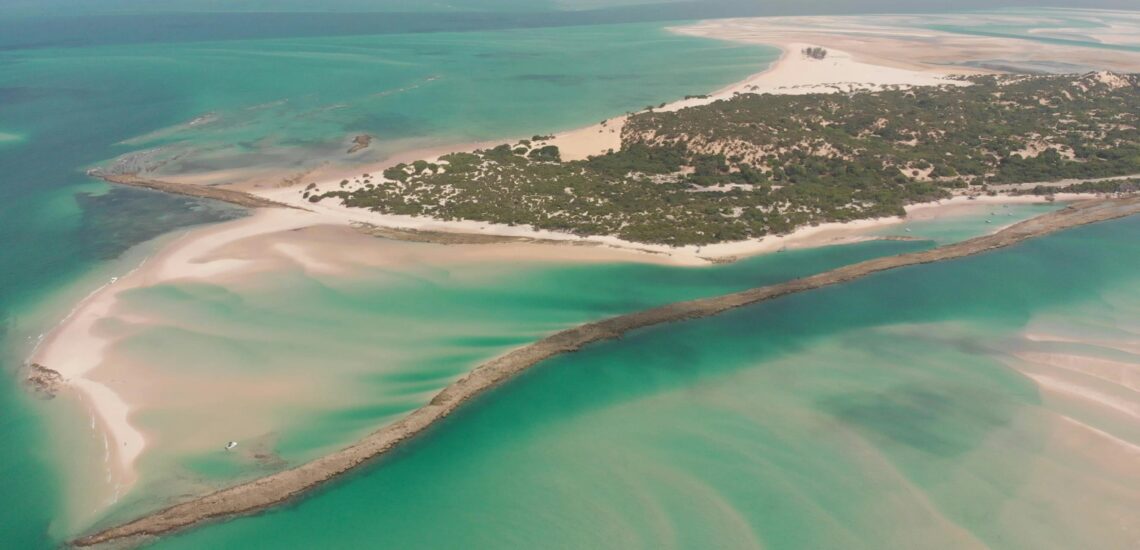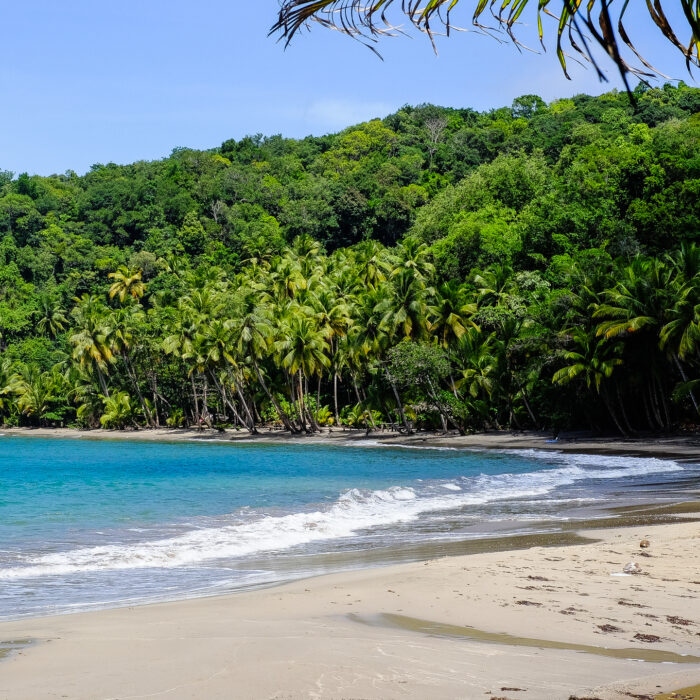Fatos rápidos sobre Moçambique:
- População: Aproximadamente 33 milhões de pessoas.
- Capital: Maputo.
- Idioma oficial: Português.
- Outras línguas: Moçambique tem uma rica diversidade linguística com várias línguas indígenas, como Emakhuwa, Xichangana e Elomwe.
- Moeda: Metical moçambicano (MZN).
- Governo: República presidencial unitária.
- Religião principal: Cristianismo (predominantemente católico romano e protestante), com uma significativa minoria muçulmana.
- Geografia: Localizada no sudeste da África, faz fronteira com a Tanzânia ao norte, Malawi e Zâmbia a noroeste, Zimbábue a oeste e África do Sul a sudoeste. Tem uma longa costa ao longo do Oceano Índico a leste.
Fato 1: Moçambique é o único país cuja bandeira contém a imagem de uma AK-47
A bandeira de Moçambique, adotada em 1983, inclui um emblema distintivo com um rifle AK-47 cruzado com uma enxada e um livro.
O AK-47 simboliza a luta do país pela independência e o compromisso contínuo com a defesa da nação. A enxada representa a agricultura e a importância da agricultura na economia de Moçambique. O livro significa educação e a aspiração do país por progresso e desenvolvimento.
Fato 2: Moçambique tem uma população muito jovem
Moçambique tem uma população notavelmente jovem. Uma parcela significativa da população tem menos de 15 anos, o que a torna uma das populações mais jovens do mundo.
Dados demográficos: De acordo com estimativas recentes, aproximadamente 44% da população de Moçambique tem menos de 15 anos. A idade média do país é de cerca de 17 anos, o que é muito mais jovem em comparação com as médias globais.
Implicações: Esse grupo demográfico juvenil apresenta oportunidades e desafios. Por um lado, uma população jovem pode impulsionar o crescimento econômico e a inovação, potencialmente contribuindo para uma força de trabalho dinâmica no futuro. Por outro lado, também apresenta desafios como a necessidade de educação, saúde e oportunidades de emprego adequadas para aproveitar o potencial desse grande segmento juvenil de forma eficaz.
Esforços de desenvolvimento: Atender às necessidades de uma população jovem requer investimentos significativos em educação, saúde e infraestrutura. Moçambique está trabalhando para melhorar essas áreas para garantir que os benefícios de sua população juvenil possam ser plenamente aproveitados.
Fato 3: Existem muitas ilhas em Moçambique
Moçambique abriga um número significativo de ilhas, que contribuem para a rica diversidade geográfica e cultural do país. O litoral de Moçambique se estende por 2.400 quilômetros, oferecendo amplas oportunidades para inúmeras ilhas e arquipélagos.
Ilhas e arquipélagos notáveis:
- Arquipélago do Bazaruto: Localizado na costa de Vilankulos, este arquipélago consiste em várias ilhas, incluindo Bazaruto, Benguerra, Magaruque e Santa Carolina. É conhecida por suas praias deslumbrantes, águas cristalinas e rica vida marinha, o que a torna um destino popular para turistas e mergulhadores.
- Arquipélago das Quirimbas: Situado na parte norte de Moçambique, este arquipélago inclui cerca de 32 ilhas. As Quirimbas são conhecidas por sua beleza natural, recifes de coral e cultura tradicional suaíli.
- Ilha da Inhaca: Localizada perto de Maputo, a capital de Moçambique, a Ilha da Inhaca é conhecida por suas belas praias, reservas marinhas e instalações de pesquisa.
Importância geográfica: Essas ilhas e arquipélagos aumentam o apelo de Moçambique como destino de ecoturismo, mergulho e férias na praia. Eles também desempenham um papel importante nos esforços de conservação e biodiversidade marinha do país.
Fato 4: No período pré-colonial, o lugar tinha seus próprios reinos
Antes do período colonial, a região que hoje é Moçambique abrigava vários reinos e impérios influentes e bem estabelecidos.
O Reino de Gaza: Um dos estados pré-coloniais mais proeminentes em Moçambique foi o Reino de Gaza. Estabelecido no início do século XIX pelo povo Shona, de língua nguni, era um reino poderoso que controlava grande parte do sul de Moçambique. O reino era conhecido por suas proezas militares e extensas redes comerciais.
O Reino de Mutapa: Ao noroeste de Moçambique, na área que agora faz parte do Zimbábue, ficava o Reino de Mutapa. Este reino teve uma influência significativa sobre as regiões do norte de Moçambique. Era conhecida por sua riqueza proveniente da mineração de ouro e do comércio com a costa suaíli.
O Império Maravi: Nas regiões central e norte de Moçambique, o Império Maravi foi outro estado influente. Era conhecida por suas redes comerciais e interações com regiões vizinhas.
Cidades-estados suaíli: Ao longo da costa de Moçambique, várias cidades-estado suaíli prosperaram. Essas cidades-estados, incluindo Kilwa, Sofala e outras, eram importantes centros de comércio e cultura, engajados no comércio em todo o Oceano Índico.
Fato 5: Moçambique é um destino de férias popular para turistas da África do Sul
Moçambique é um destino de férias popular para turistas da África do Sul, em grande parte devido às suas belas praias, vida marinha vibrante e atrações culturais. O apelo do país é reforçado por sua proximidade com a África do Sul, tornando-o uma opção atraente para uma viagem relativamente curta.
Novos desenvolvimentos de infraestrutura: melhorias recentes na infraestrutura, como o desenvolvimento de novas estradas, tornaram as viagens para Moçambique mais acessíveis e convenientes. Por exemplo, a atualização da rede rodoviária que liga a África do Sul a Moçambique melhorou significativamente a facilidade de viagem para turistas. Essa nova infraestrutura facilita viagens mais suaves e eficientes, contribuindo para o aumento do turismo dos países vizinhos.
Dirigindo em Moçambique: Embora as novas estradas tenham melhorado o acesso, dirigir em Moçambique ainda pode ser uma experiência única. Os viajantes podem encontrar várias condições, desde rodovias bem conservadas até estradas rurais mais desafiadoras. Em algumas áreas, as estradas podem estar menos desenvolvidas e os viajantes devem estar preparados para as diferentes condições das estradas. Além disso, as práticas locais de direção e a sinalização rodoviária podem ser diferentes das da África do Sul, o que pode afetar a experiência de dirigir.
Nota: Ao planejar uma viagem solo pelo país, verifique se você precisa de uma Permissão Internacional para Dirigir em Moçambique para alugar e dirigir um carro.
Fato 6: Em Moçambique, diversidade linguística, religiosa e nacional
Moçambique é caracterizado por uma significativa diversidade linguística, religiosa e nacional, refletindo sua rica herança cultural e história complexa.
Diversidade linguística: Moçambique é o lar de uma infinidade de idiomas. O português, a língua oficial, é usado no governo, na educação e na mídia. No entanto, também existem mais de 40 línguas indígenas faladas em todo o país. As principais línguas bantu incluem Chichewa, Shangaan (Tsonga) e Makhuwa. Essa diversidade linguística reflete os variados grupos étnicos e influências históricas presentes em Moçambique.
Diversidade religiosa: Moçambique tem uma paisagem religiosa diversificada. A maioria da população se identifica como cristã, com o catolicismo romano e várias denominações protestantes sendo proeminentes. Há também uma população muçulmana significativa, particularmente ao longo da costa e nas áreas urbanas. As práticas e crenças religiosas indígenas também estão presentes e muitas vezes coexistem com o cristianismo e o islamismo, refletindo a mistura histórica e cultural do país.
Diversidade nacional: A diversidade nacional em Moçambique é evidente em sua composição étnica. Os principais grupos étnicos incluem Makhuwa, Tsonga, Chewa, Sena e Shona, entre outros. Cada grupo tem suas próprias práticas culturais, tradições e estruturas sociais distintas. Essa diversidade étnica contribui para a vibrante tapeçaria cultural de Moçambique, influenciando tudo, desde culinária e música até festivais e arte.
Fato 7: Moçambique é conhecido por suas cidades comerciais há séculos
Moçambique tem uma longa história de cidades comerciais que foram importantes centros de comércio e intercâmbio cultural por séculos. A região costeira de Moçambique, em particular, tem sido um importante centro de comércio devido à sua posição estratégica ao longo das rotas comerciais do Oceano Índico.
Cidades comerciais históricas:
- Sofala: Uma das cidades comerciais históricas mais notáveis de Moçambique, Sofala foi um importante centro comercial nos séculos XI e XII. Fazia parte da extensa rede comercial da costa suaíli, realizando comércio com comerciantes do Oriente Médio, Índia e China. Sofala era conhecida por seu envolvimento no comércio de ouro e era um porto importante para as rotas comerciais transoceânicas.
- Kilwa Kisiwani: Embora localizada no que hoje é a Tanzânia, Kilwa Kisiwani estava intimamente ligada a Moçambique por meio do comércio. Era uma poderosa cidade-estado que controlava as rotas comerciais ao longo da costa leste da África e tinha interações econômicas e culturais significativas com as cidades costeiras de Moçambique.
- Inhambane: Esta histórica cidade portuária foi outro ator importante na história comercial de Moçambique. Inhambane tem sido um centro comercial desde o século XVI, engajando-se no comércio com comerciantes europeus, árabes e asiáticos. Era conhecida por seu comércio de especiarias, marfim e ouro.
Impacto do comércio: Essas cidades desempenharam um papel crucial nos intercâmbios econômicos e culturais entre a África, o Oriente Médio e a Ásia. Eles facilitaram o fluxo de bens, ideias e práticas culturais, contribuindo para o desenvolvimento das regiões costeiras de Moçambique e moldando sua trajetória histórica e econômica.
Fato 8: A caça furtiva é comum em Moçambique
A caça furtiva tem sido um problema grave em Moçambique, com impactos significativos em suas populações de vida selvagem. O último rinoceronte em Moçambique foi morto em 2013, um marco trágico que ressaltou a gravidade da crise da caça furtiva. A caça furtiva de rinocerontes, impulsionada pelo alto valor do chifre de rinoceronte nos mercados ilegais, esgotou gravemente a população de rinocerontes do país. A perda desses animais icônicos destacou a necessidade urgente de medidas de conservação mais eficazes.
Em resposta, Moçambique intensificou os esforços contra a caça furtiva, colaborando com organizações internacionais e melhorando a aplicação da lei para proteger sua vida selvagem remanescente. Essas iniciativas incluem o fortalecimento de áreas protegidas e o envolvimento das comunidades locais na conservação. Apesar desses esforços, o desafio da caça furtiva persiste, exigindo atenção e recursos contínuos para evitar mais perdas e apoiar a recuperação das espécies ameaçadas de extinção de Moçambique.
Fato 9: O Parque Nacional da Gorongosa é considerado o melhor da região sul-africana
O Parque Nacional da Gorongosa é amplamente considerado como um dos melhores parques nacionais da África Austral, celebrado por sua extraordinária biodiversidade e esforços bem-sucedidos de conservação. Localizado no centro de Moçambique, o parque cobre mais de 4.000 quilômetros quadrados e apresenta uma variedade de ecossistemas, de savanas a zonas úmidas, que sustentam uma rica variedade de vida selvagem.
A reputação do parque é reforçada por sua notável recuperação e restauração. Após graves danos durante a guerra civil de Moçambique, extensos esforços de reabilitação revitalizaram seus ecossistemas e populações de vida selvagem. A colaboração com organizações de conservação, particularmente o Projeto de Restauração da Gorongosa, tem sido fundamental neste processo.
Moçambique é profundamente afetado pelas mudanças climáticas, enfrentando uma série de desafios ambientais e socioeconômicos. O extenso litoral do país e a dependência da agricultura o tornam particularmente vulnerável. O aumento da frequência e severidade de eventos climáticos extremos, como ciclones, inundações e secas, causaram danos significativos à infraestrutura, à agricultura e aos ecossistemas naturais.
Fato 10: Moçambique é fortemente afetado pelas mudanças climáticas
As áreas costeiras estão particularmente expostas ao aumento do nível do mar e à erosão costeira, que contribuem para inundações e deslocamentos. A agricultura, um setor crucial para a economia de Moçambique e os meios de subsistência de muitas pessoas, é interrompida pela mudança dos padrões de chuvas e secas prolongadas, que afetam o rendimento das colheitas e a segurança alimentar.

Publicado Setembro 15, 2024 • 10m de leitura





